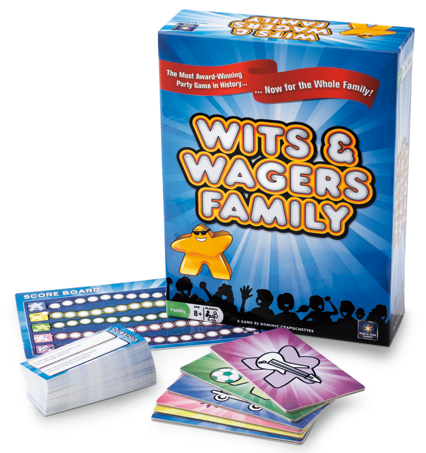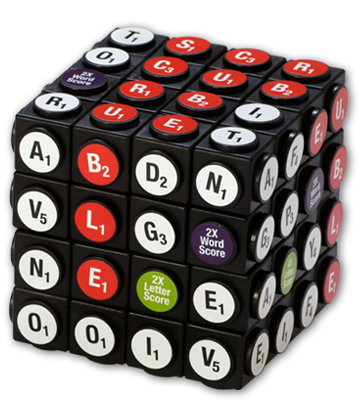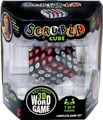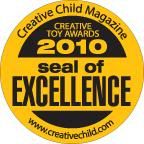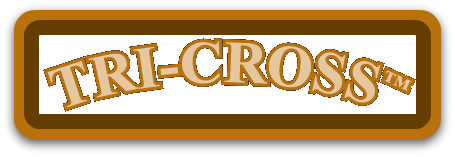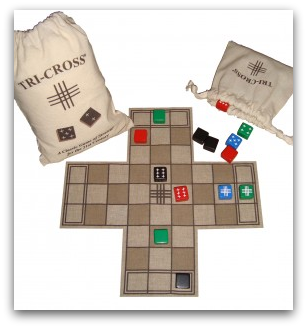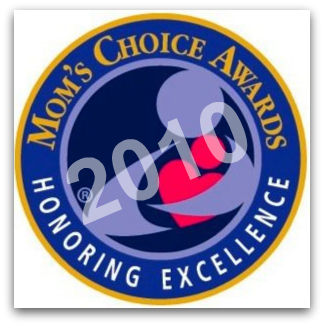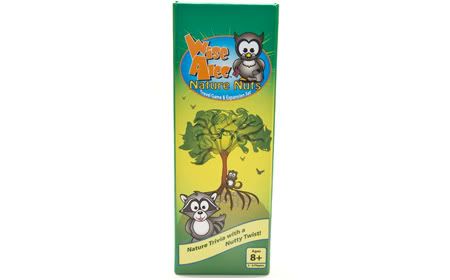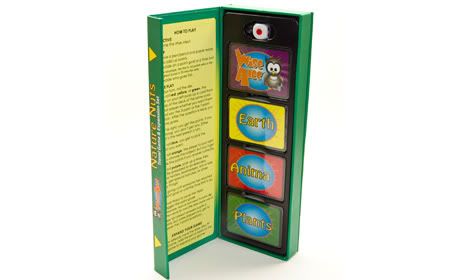Say Anything Family was just released for 2011. I have never played the previous version that did not have "Family" attached, but I can only imagine that the questions in this version have been adjusted so that they are more appropriate for kids.
Say Anything Family is a game for anyone ages 8 and up. It is a game for 3-6 players, and more can play by breaking off into teams. The game comes with:
• six Answer Boards and six little dry erase markers;
• a "Select-o-Matic 6000";
• 2 Player Tokens per person (12 total);
• a Score Board;
• a stack of Question Cards with 6 questions to choose from on each card (a total of 360 questions);
• a sheet with directions and a sheet with information about other Northstar Games.
It takes about 2 minutes to learn to play, and about 20 minutes to play (the box says 30 minutes, but that wasn't my experience). To play the game, each player receives an Answer Board, a dry erase marker, and 2 Player Tokens, all color coordinated. A Score Keeper is selected, and the Score Board is placed where the Score Keeper can easily tally the score each round.
The youngest player gets to go first. The Select-o-Matic 6000 is given to this player, with a question card, and he/she picks a question to read. Each person puts an answer on their Answer Board. The Answer Boards are all put into the center of the table. The person who read the question picks the answer he or she likes best by turning the arrow on the Select-o-Matic 6000 to the color code for the Answer Board of that answer and placing the Select-o-Matic 6000 face down on the table. [In the beginning it is easy to mistake the Select-o-Matic 6000 for a spinner, but it does not spin that way and is not intended to be used as a spinner.] Then each player uses Player Tokens to guess which answer the question asker chose. In this photo, the sample question was, "In my opinion, ...If I could have any middle name, what would it be." So the guesses need to be made based on what the players think the question asker would like to have as a middle name.
At this spot, the Select-o-Matic had not been used yet, and it should have been upside-down.
The question asker then turns over the Select-o-Matic 6000 so everyone can see how they did, and the scores are tallied. One point goes to the person who wrote the answer that the question asker liked best, and one point goes to each person who had a Player Token on that Answer Board. The score for each player is added to the Score Board.

The next question is read by the person to the left of the previous question asker, so the Select-o-Matic 6000 is also passed to that person. The game is over when each person has asked a question twice, and the winner is the one with the highest score. In the event of a tie, the younger player is the winner.
My son has said several times now, "I really like this game!" This surprised me a little bit because my own personal opinion was a little less favorable. Maybe I have just been in a contrary mood when I have played, I don't know, but when I get the question cards I have had difficulty deciding on a question that I really cared about. And I have had difficulty having an opinion on the questions. For example, here are some of the questions that I just didn't even care about:
In my opinion...
• What's my biggest pet peeve? (Do I have a biggest pet peeve?)
• What's the best video game ever? (Do I even have any idea?)
• What would be the coolest thing to do with a $100 million lottery jackpot? (Like you would only do one thing with all that money?)
So, I was probably being ornery. Here are some other sample questions that are fun:
In my opinion...
• What's the best toy of all time?
• What's the most important invention of all time?
• Which TV show prop would be the coolest to own? (I definitely said the Tardis!)
So overall this game has been a hit in our family. Here are things about it that I liked:
• It's fun to have a game that you write on/wipe off with a napkin;
• It's quick and easy to learn; quick and easy to play;
• This game is so easy to play that my son can easily take it out on his own and play it with his friends. (We own some games that I never want him to play without an adult present.)
• This game is in depth enough that it can interest players of all ages.
• I like the neat make-up of the box for storing the game in.
Things I didn't like:
• Well, like I already said, I didn't like all of the questions so well. If I were going to change anything, I would probably do the questions differently. I think basically I probably prefer factual questions to opinion questions, so the problem is probably with me, not the game.
I would generally recommend this game to anyone as a good family game. I like for families to play games together, so I would recommend this to most families to add to their game selection.
Say Anything Family is available from Amazon.com for $13.85 (and Super-Saver Shipping is available). It would make a great Christmas gift.
The makers of Say Anything Family, Northstar Games, also makes the original Say Anything game, Wits & Wagers Family, and the original Wits & Wagers game (less suitable for young children).
Disclosure: I received a free Say Anything Family game in exchange for my honest opinion. I received no other compensation (other than the game), and this page contains my honest opinions.
This has been a TOS Homeschool Crew Review.

Throw me a bone! Leave me a comment! I love comments!








